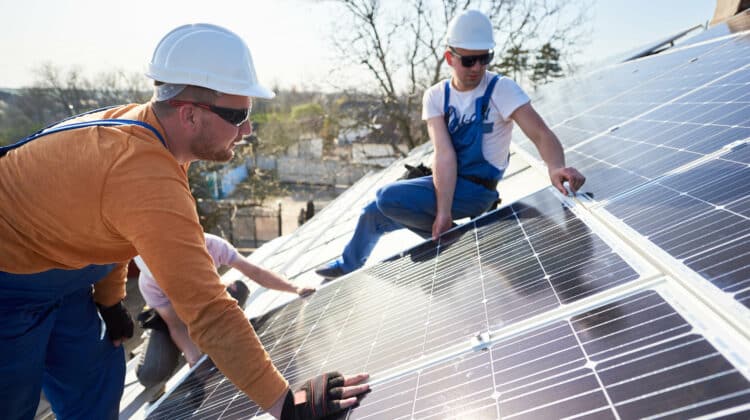
Anyone who wants integrated solar roof technology will hear the term 3 in 1 Roof cost vs Tesla Solar Roof cost. The professionals have quite a bit to say about them.
These products cost more than your traditional solar panels. Because of their high price, you want to ensure you get the best value for your money. So, how do you choose between the two?
The 3 in 1 roof and Tesla Solar roof v3 supply a product with 2 in 1 capability. They serve as solar panels while doubling as a kind of roofing material. For this reason, they have the name Integrated Solar Systems. It is also for this reason that their price might be worth it.
But how do these two compare cost-wise when deciding to get one or the other? Are they even worth throwing out your reliable roof and traditional solar panels?
We are here to find out.
Table of Contents
What Drives Solar Roof Cost
Three main factors determine the final cost of your integrated solar system.
How much electricity your home uses every day
What affects electricity cost at your home?
- The number of appliances you have
- How often you use these appliances
- How long you use these appliances
- The wattage of each appliance
- The kilowatt-hour rate of your electricity company
The location of your house or structure
The more hours of sunshine your house gets per day, the fewer solar roof tiles you need. Depending on where you live, you may have to get more or fewer tiles to fulfill your electricity needs. If you need more solar roof tiles, the cost will be higher. If you need less, the price will be lower.
The same is true for the 3 in 1 solar roof and the Tesla solar roof. If shade covers your solar roof tiles during the day, the sunlight reaching the cells reduces. That period in the shade has the potential to affect your electricity output.
There are two ways to work around this problem.
- Placement Of Solar Tiles
- Get Rid Of Obstructions
Not all the tiles on your solar roof will generate electricity. Some of the tiles are dummies. Your roofer should install the solar tiles on the side of your house that gets more sunshine for the day.
Where possible, get rid of objects casting shadows over your roof. For example, trim the tree branches hanging over your home.
These issues affect the 3 in 1 Roof and Tesla Solar Roof v3 the same way.
The Square Footage
A large roof will need a larger quantity of roof tiles to cover the square footage. As I mentioned in the previous segment, not every tile in your order will have solar capacity. Some of the tiles will be dummies. The Dummy tiles are cheaper than the tiles with photovoltaic cells.
You only need the number of solar tiles which will generate the amount of electricity to meet your needs. But a grander home could mean more electricity use. More electricity usage means you need more expensive solar tiles.
Again, this is similar in both the 3 in 1 Roof and Tesla Solar Roof v3.
Roof Complexity
Roof complexity does not have a lot of impact on the performance of the solar tiles. Whether the position of those panels makes the best use of the sunlight your home gets is what matters.
For complexity, it is different. What helps determine the cost of your solar roof is how easy your roof is to access and lay down the tiles. The placement of the tiles should make the best use of the surface area of your roof. Sometimes, this is a challenge.
When it comes to complexity, there are three categories to consider:
Simple
In a simple complexity design, a roof will have
- A single level
- The mounting plane will be uncrowded.
- Few obstructions
- skylights
- attics
- chimneys
- satellite dishes
- vents
- valleys
- hips and, other features mounted on the roof
- Low pitch or slope
Your home only has one floor.
The mounting plane refers to the surface area to install your roof. A mounting plane that is uncrowded has a smaller surface area to cover. It also has no added angles. An example of a mounting plane that is uncrowded is a simple gable roof.
Obstructions may include:
A simple complexity roof has few of these. Solar tiles take less time to install and are easier to set in place.
The pitch or slope of your roof refers to how steep that roof is. A simple complexity roof has a low pitch. A low pitch roof provides easy access and poses less risk to roofers.
Intermediate
In an intermediate complexity design, a roof will have
- More than one level
- More angles on the roof
- Many obstructions
- Higher pitch or slope
That means your home is a split-level home or two floors.
More angles create more crowding on the mounting plane of your roof. An example of roofs with more crowding or angles is hipped roofs.
The roof of your home has more features like the ones listed under simple complexity.
The higher the pitch or slope of your house, the greater the surface area to cover. You will need more tiles to complete your whole roof.
A higher pitch roof is also more difficult to access and install.
Complex
In a complex complexity design, a roof will have:
- Multi-level roof
- Heavy crowding on mounting plane
- Several obstructions
- Steep pitch or slope
Your split-level home has more than two floors.
There may be several sections and angles on the different levels of your roof.
The roof of your home has several added features. These include the ones mentioned under the simple complexity roof and more.
A steep pitch has an even wider surface area to cover with roof tiles. A larger surface area means you need to buy more tiles. It also means that your roof is more difficult to access.
With the Tesla Solar roof v3, and the 3 in 1 roof, a simple design is cheaper to install. The more complex your roof design, you should expect a price jump.
But here is the difference.
Many Tesla Solar Roof customers reported unexpected added costs to their balance. These added figures came after installation. So far, 3 in 1 roof customers have not made this complaint. I searched but could not find a single review. No bad reviews exist, but no good reviews exist either.
The company does say that the type of roof you have plays a role in the installation cost. But they also say that the 3 in 1 Roof tiles are easy to install. Why? Because of their make-up.
Whether you want to get the 3 in 1 roof or the Tesla Solar Roof, you need to know what you are getting for your money. So, it is only fair that we examine and compare how they make these products.
3 in 1 Roof Composition .vs. Tesla Solar Roof Composition
We are not sure what is in the Tesla Solar roof tiles. The company has been mum on almost every detail when it comes to this product. Even the Tesla Solar tile efficiency remains a mystery.
What we do know is that Tesla claims that this roofing material is durable. It is stronger than regular roofing tiles and built for all kinds of weather.
3 in 1 Roof offers transparency by releasing quite a bit of detail about their product. So what do we know? The 3 in 1 roof has three layers.
The First Layer
We know that it has a layer of Densdeck prime. Densdeck prime is an underlying layer. It adds both stability and strength to the roof tiles. Densdeck prime also adds insulation and resistance to fire, wind, and moisture to the 3 in 1 Roof tiles.
The Second Layer
Flintlastic SA makes up the second layer of the 3 in 1 roof tiles. Flintlastic SA is super adhesive roofing material. This material makes installing the 3 in 1 roof tiles on a low pitch or slope roof easy.
It also has a polyurethane foam adhesive approved for steep roof pitches or slopes.
These features get rid of the roof complexity problems Tesla has with their product. Thus installation is cheaper, easier, and faster.
The Third Layer
The first two layers form part of all the 3 in 1 Roof tiles. But remember, I mentioned that these tiles come with dummies or a non-solar component.
The solar tiles contain photovoltaic cells. The dummy tiles do not. The photovoltaic cells allow your integrated roof system to work by trapping sunlight.
The point of all this is, we know what is in the 3 in 1 roof tiles. Because we have that knowledge, it is easier to make informed decisions about their cost.
There is a lot of mystery surrounding the Tesla Solar Roof tiles. The only reason to invest in them is having the capital and liking the way they look.
What else do we know about the 3 in 1 roof tiles?
- They are two inches thick but lightweight.
- The photovoltaic or solar tiles weigh 4 pounds for each square foot.
- The lightweight is part of the reason these tiles install with such ease.
- They are easy and quick to install, no matter your roof complexity.
- They resist winds up to 200 miles per hour (a category five hurricane)
- Fire resistant
- Energy efficient
- In case a tile gets damaged, the damaged one is easy to remove and replace
- It has a self-healing coating technology made of concrete. The self-healing feature repairs cracks in the panels when you apply water.
- Comes in 12 different colors and different styles
- Tiles are durable and will not break underfoot.
- Has a 50-year warranty.
These upsides to the 3 in 1 Roof do tempt. If you live in a hurricane belt, especially. It is still a risky investment. Why? There is not enough data to back up the claims. I suppose the 50-year warranty may be a neat offset for those risks. If anything goes wrong, it is possible to get your roof replaced.
What Do We Know About Tesla Solar Roof Tiles?
Tesla is pretty opaque on the details and proprietary of its products. So much so, although it has no experience in roofing, Tesla did its own roof installations at first. We suspect this was one reason for the backlog of solar roof orders and why it took so long to install.
Tesla is now training roofers and subcontracting roofing companies to do their installations.
Here is what we know so far:
- The Tesla Solar Roof tiles are tempered glass solar roof tiles
- Tiles are durable and will not break underfoot.
- They are 15 by 45 inches.
- Non-solar roof tiles weigh 7 pounds for each square foot.
- Solar tiles weigh 10 pounds for every square foot.
- In the beginning, it took about two weeks to install a simple complexity roof. Tesla boasts cutting that down to about 3-7 days. But these are simple roofs. We guess a complex roof may take more time.
- They resist winds up to 160 miles per hour.
- In case a tile gets damaged, you must remove the entire line above to replace it. The explanation behind this is the way the tiles connect during installation.
- The Tesla Solar Roof V3 is the third version of this product. The V3 is the only one available for installation.
- Not available in any other colors or styles. Though, Tesla promises that this will change.
- Has a 25-year warranty.
Like the 3 in 1 roof, Tesla’s latest product is not tested or proven. Trusting in their ability to perform and last as the company promised is risky. Although 25 years is not 50, it is still a nice little cushion while you test the worth of your new Tesla V3 roof.
General Solar Roof Cost
From the previous section, you can tell that the 3 in 1 roof has advantages over the Tesla V3 Solar roof. We touched on the Installation cost. But we have not yet worked out the price for the panels. Price, most times, is the decision-maker for the average joe.
So is there much difference between the 3 in 1 roof cost and the Tesla V3 solar roof cost? Yes, a few dollars per square foot. Follow the breakdown below.
3 in 1 roof .vs. Tesla Solar Roof
- 3 in 1 Roof – $18-$24 per watt
- Tesla Solar Roof $22-$28 per watt
The Tesla solar roof cost comparison to the 3 in 1 roof may not look like much now. After all, there is only a few dollars difference between wattage costs. But in the end, the little extra costs pile up.
Take a look at how.
To install a 3 in 1 Roof on a 2000 square foot home, 3 in 1 Roof estimates you will need an 8.5-kilowatt system. The cost to install these tiles will be in the region of $42,850 to $68,650. Note, these figures are estimates and do not include other variables.
To install Tesla tiles v3 on a 2000 square foot home, you will need a tesla 10-kilowatt solar system. The cost of this larger kilowatt system will range between $52,360-$80,100. These factors are estimates and do not factor in roof complexity and other variables.
Is the Premium Worth It?
One of Tesla solar roof’s earliest customers said he paid $100,000 for his solar roof system. A hundred thousand dollars is a lot of money. But, this California resident had an electricity bill of $450 during the summer months. After his solar roof installation, he saw a reduction of $410 in his electricity bill.
Plus, he said he needed a new roof anyway.
Tesla claims that its Solar roof will pay for itself in the future. We are talking about the very distant future. 18-20 years if you do the math.
The 3 in 1 roof returns timeline follows the same pattern.
If you need to install a new roof and have the money to spare, then why not? The 3 in 1 roof and Tesla Solar Roof come with sizeable warranties.
Is it worth it to remove a working roof and replace it with one of these? I would not say so.
Installation Process and Cost
Earlier, we gave you an idea of how the complexity of your roof may affect the cost of your solar tiles. But those numbers do not include the process and cost of installation. Here we combine the two.
I also said I searched for a 3 in 1 roof review and could not find one. Not videos, not written testimonials, nothing. What I can offer you are the claims of the company for easy and fast installation. According to their video presentation, it goes on in two shakes of a lamb’s tail. While I cannot say how long that is, it does sound quick.
Why are they so easy and quick to install? I suspect it has something to do with the design of the tiles. Their technology makes them suitable for every type of roof, no matter the complexity. Because they are so quick and easy to install, this may make 3 in 1 Roof installation cheaper than Tesla Solar Roof.
Customers will have to pay a deposit of $500 as a show of commitment.
It is time to move on to the Tesla Solar Roof.
There is more information available on Tesla Solar Roof Installs than the 3 in 1 Roof. We have more reviews and more information from the company that makes them.
After its first roll-out, the Tesla Solar roof took two weeks to install, twenty roofers, and about $100,000. So it was reported. And that information is for a simple complexity roof. Tesla went back to work on this product. Its goal was to improve installation and came up with two other versions. This leads us to where we are with the V3.
So how do the changes they made compare?
As of April 2021, there still is not a lot of data to compare. But here is what we know so far.
The wait for solar panel installation is long. A simple complexity roof can still take up to seven days. And you can expect unexpected increases in prices to your original quote. Even if you already signed your installation contract with Tesla, this is true.
How do we know this? Because customers took to social media to complain. The company explained the jack in prices as significant mistakes. They had not factored roof complexity into their original quotes.
One New York City customer began her transaction with Tesla with a $60,000 quote. That transaction ended with a $112,000 bill.
With the new Installation calculator, Tesla hopes to give more accurate figures.
Customers will have to pay a $1000 deposit as a show of commitment.
You need no mechanical fasteners to install either the 3 in 1 Roof or Tesla Solar Roof. The integrity of the underlying layer of your roof remains intact.
Conclusion
We laid out all the information we gathered on the 3 in 1 roof and Tesla Solar roof. The main takeaway here is that these products are still in the early stages. Not enough data exists to comment with certainty on what will happen in the future. Only time will tell how these products measure up against the claims and promises made 3 in 1 roof and Tesla.
What can we tell you after all that we learned? If you are putting up a new home, it might be worth trying either the Tesla Solar Roof or the 3 in 1 Roof. If you plan to get a new roof, they may be worth it as well. If you have the capital to spend and like how they look, you qualify to get either one of these products.
In the end, whether the 3 in 1 roof or Tesla Solar Roof makes financial sense is up to you to decide.
Keep in mind there are cheaper, reliable, tested solar alternatives out there.





